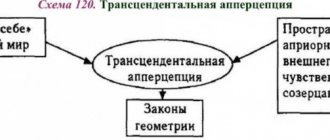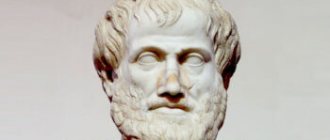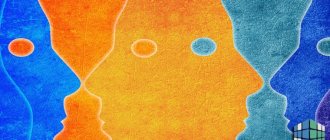Three-dimensional theory of emotions by W. Wundt.
Three-dimensional theory of emotions by W. Wundt. V. Wundt put forward a theory according to which the structure of emotion is characterized by three dimensions: pleasure - displeasure, excitement - calmness and tension - resolution.
To study emotions as subjective elements of a person’s direct experience, he used the method of introspection, and also recorded changes in organic reactions, mainly breathing and pulse.
According to Wundt, emotional experiences are characterized by one, two, or all three of these polar dimensions. Thus, pure forms of pleasure or displeasure arise, according to Wundt, in connection with olfactory and gustatory sensations, as well as the sensation of pain. But the sensation of red, in addition to the pleasure or displeasure it brings, causes an emotional state of excitement, while the sensation of blue has a calming effect. Tension is found to a greater extent in connection with attentional processes associated with the expectation of an event, and resolution occurs when the expected event has occurred. In this case, the emotion can appear in all the complexity of its psychological structure: in addition to the main quality - tension - it can manifest excitement or calmness, as well as pleasure or displeasure. Each of these three “dimensions” manifests itself in emotion not only as a subjective state of a certain quality, but also in varying degrees of intensity. Due to the fact that emotions in their psychological structure are a variety of three “dimensions”, each of which can continuously and widely vary in the degree of its intensity, an infinite variety of emotional states and their shades is obtained. Wundt sought to support his theory with objective physiological data. Each of these six qualitative features of emotions is characterized by certain changes in pulse and respiration. In connection with certain emotional states, these physiological processes naturally change in their strength and speed.
Wundt, however, notes that these changes in pulse and respiration are observed only when the corresponding emotional states are taken in their pure form. In reality, emotions are always associated with a huge number of different accompanying circumstances, as a result of which physiological phenomena cannot always serve as an unambiguous indicator of the corresponding emotional states. Wundt's theory was criticized by the American psychologist E. Titchener. As a result of his experiments, the following conclusions were made: 1) the six emotional polarities identified by Wundt are not independent of each other. The statements of the subjects participating in the experiments about the states of excitement and tension, calmness and resolution they experienced in certain situations coincided with judgments about their pleasure or displeasure; 2) excitement - calmness and tension - resolution are not, unlike pleasure or displeasure, elementary subjective states; they represent complex complexes of kinesthetic and organic sensations, accompanied by experiences of pleasure or displeasure.
Consequently, according to Titchener, only pleasure and displeasure are simple and independent qualities that characterize the structure of emotions, while the remaining dimensions indicated by Wundt are in fact not such elements. This approach, however, despite the value of the facts identified by Titchener, again revives the ideas of a simple structure of emotional phenomena. Other scientists also made critical comments that emotions are not a mechanical sum of a certain number of quantitatively changing subjective states of pleasure, excitement, tension, etc. Numerous experimental studies have also shown the absence of a strictly regular correspondence between emotional states and accompanying changes in heart rate and breathing, which Wundt relied on in his theory. Wundt's merit should be recognized in the fact that he was the first to point out the complexity of the psychological structure of emotional phenomena.
18. Evolutionary theories of emotions (C. Darwin, R. Plutchik).
The first scientific ideas about emotions as adaptive reactions of the body were formulated by Charles Darwin, who showed the evolutionary path of development of emotions and explained the origin of their physiological manifestations.
The main idea of Darwin's ideas is that most human emotional reactions are either useful (promoting adaptation) or represent remnants (rudiments) of expedient reactions developed during the process of evolution in the struggle for survival. According to Darwin, three basic principles guided the evolutionary development of emotions: 1) the principle of association
— the combination of emotions with appropriate adaptive reactions that are beneficial for the body led in the process of evolution to the formation of certain associations, due to which these reactions began to appear automatically when experiencing these emotions, even if there was no need for them.
Sweaty hands when afraid means that in the ape-like ancestors of humans, this reaction in case of danger made it easier to grab tree branches, etc.; 2) the principle of antithesis
- emotions of opposite sign cause opposite behavioral reactions;
3) the principle of the direct influence of nervous excitation on the body.
This theory was the first to draw attention to the possibility of characterizing emotions by their somatic expression.
According to the fundamental provisions of the theory proposed by the American psychologist R. Plutchik, emotions: 1) are mechanisms of communication and survival based on evolutionary adaptation; 2) have a genetic basis; 3) are hypothetical constructions based on obvious phenomena of various classes; 4) represent chains of events with stabilizing feedbacks that create a certain type of behavioral homeostasis; 5) correlate with each other along three main dimensions – intensity, similarity and polarity; 6) correlate with a number of derived conceptual areas.
According to the first position, emotions are a means of adaptation and play an important role in survival at all evolutionary levels. However, problems of survival require a differentiated response to prey and predator, food and an individual of one’s own species, etc. Consequently, emotions will vary depending on the adaptive response prototypes associated with them. Communication occurs through eight basic adaptive reactions, which are prototypes of eight basic emotions (these are incorporation, rejection, protection, destruction, reproduction, reintegration, orientation, exploration) and the third position. Hypothetical models (see table):
The fourth position of the theory explains the sequence of the emotional process: emotions are caused by various events that must be cognitively assessed in terms of their significance for the well-being of the individual. The assessment results in various experiences as well as certain physiological changes. Physiological changes are in the nature of anticipation reactions associated with various stresses or impulses (urge to explore, attack, etc.). Depending on the strength of heterogeneous impulses, a resultant appears in the form of observable behavior, which is designed to have an effect on the original stimuli. The effectiveness of this complex feedback system is to reduce the threat or change the dangerous situation in such a way that a temporary behavioral homeostatic balance is achieved. The fifth proposition suggests that the relationships between emotions can be represented in the form of a three-dimensional structural model: intensity - similarity - polarity. This position also includes the idea that there are primary and derivative or mixed emotions. For example, pride = anger + joy; love = joy + acceptance; curiosity = surprise + acceptance; hatred = anger + surprise; contempt = anger + disgust; disappointment = surprise + grief; pity = grief + disgust, etc. The sixth position of the theory logically follows from the previous one. For example, sociability is associated with a combination of joy and acceptance, and "displacement" is seen as an unconscious way of coping with anger that cannot be expressed directly and with impunity. Social regulators (superego phenomena) of human behavior can be understood as a combination of fear and other emotions (for example, modesty = fear + acceptance), and anxiety as a combination of fear and expectation. Therefore, analyzing situations that give rise to fear in a person and identifying a person’s expectations in relation to such situations helps to understand the dynamics of anxiety.
Physiological theories of emotions (peripheral theory of James-Lange), biological theory of P.K. Anokhin, the central theory of Cannon-Bard, the anatomical and physiological theory of J. Gray, behaviorist theory).
List of used literature
- Afanasyev A.Yu. Syntax of love / A.Yu. Afanasiev. – M.: Izvestia, 2013.
- Vilyunas V.K. Psychological mechanisms of human motivation./ V.K. Viliunas. - M.: Moscow State University Publishing House, 1986.
- Vilyunas V.K. Basic problems of the psychological theory of emotions / V.K. Viliunas. – M.: Psychology of emotions. Texts, 1984.
- Wundt V. Essays on psychology. - M., 1912.
- Vygotsky L. S. Spinoza and his teaching about emotions in the light of modern psychoneurology // Questions of Philosophy. - 1970. - No. 6.
- Darwin Ch. On the expression of emotions in humans and animals / Ch. Darwin. – St. Petersburg: Peter, 2001
- James W. Psychology / W. James - M.: Nauka, 1991
- Ilyin E.P. Emotions and feelings / E.P. Ilyin. - St. Petersburg: 2001.
- Rubinstein S. L Being and consciousness. About the place of the psyche in the universal interconnection of phenomena of the material world. - M., 1957.
- Rubinstein S. L Fundamentals of general psychology. - M., 1946 (reprint - St. Petersburg: Peter, 1999).
- Ekman P. Psychology of emotions. I know how you feel /P. Ekman - St. Petersburg: Peter, 2012.
- Lectures (video) on the course “General Psychology” by Moscow State University professor V.V. Petukhova.
Elements of consciousness - the basis of structuralism in psychology according to Titchener
Titchener believed that consciousness is structurally composed of the following elements:
- Sensations are considered the main elements of perception. They are felt by a person in the form of smells, visual images, taste sensations, and sounds. The cause of sensations is the objects of the physical world around us.
- Images reflect experiences that have no connection with the present moment and occur, for example, in human memory. Titchener believed that it is the image, and not the word, that is the main component of any idea.
- Emotional states manifest themselves in the external world in the form of mental experiences, such as anger, fear, love or hatred.
The scale of research carried out by Titchener is striking. Thus, in his work “Essays on Psychology,” he describes about 44 thousand elementary sensations that he discovered during experiments. Moreover, each sensation had unique characteristics and was different from other sensations, which was documented.
Subject and method of structuralism in psychology
Structuralists call the subject of psychology the study of the structure of consciousness using experimental methods. In turn, the psyche consists of conscious experience, broken down into its simplest elements, the totality of which will be discussed in detail below.
Structuralists used introspection as a method of cognition. Their studies involved specially trained people who could describe the processes occurring in their psyche, without reference to the stimuli used by the experimenters. The training of observers was considered complete when introspection became such a habitual and unconscious action for them that these people often became completely immersed in themselves and lost the ability to carefully and concentratedly monitor events in the external world.
Criticism of structuralism
The most severe criticism from other movements in psychology and philosophy fell on the method of introspection (introspection) preached by Wundt and Titchener. The accusation that this method was unscientific appeared 100 years before the publication of the first works of the structuralists, and was put forward by the famous philosopher Kant, who noted that introspection inevitably distorts conscious experience, since consciousness is influenced by observation.
The founder of positivism, O. Comte, criticizing introspection, wrote that in order to carry out observation, the human mind must be divided into 2 halves: the observing and the observed. From Comte's point of view, this is impossible, which means that introspection cannot be a reliable research method.
Also, the approach of the structuralists to the study of the human psyche was considered artificial; other schools of psychology did not recognize their postulate that it was possible to restore the experience in its original form by combining several of its constituent elements. Opponents of structuralism believed that mental phenomena were too complex to be broken down into their simplest parts.









